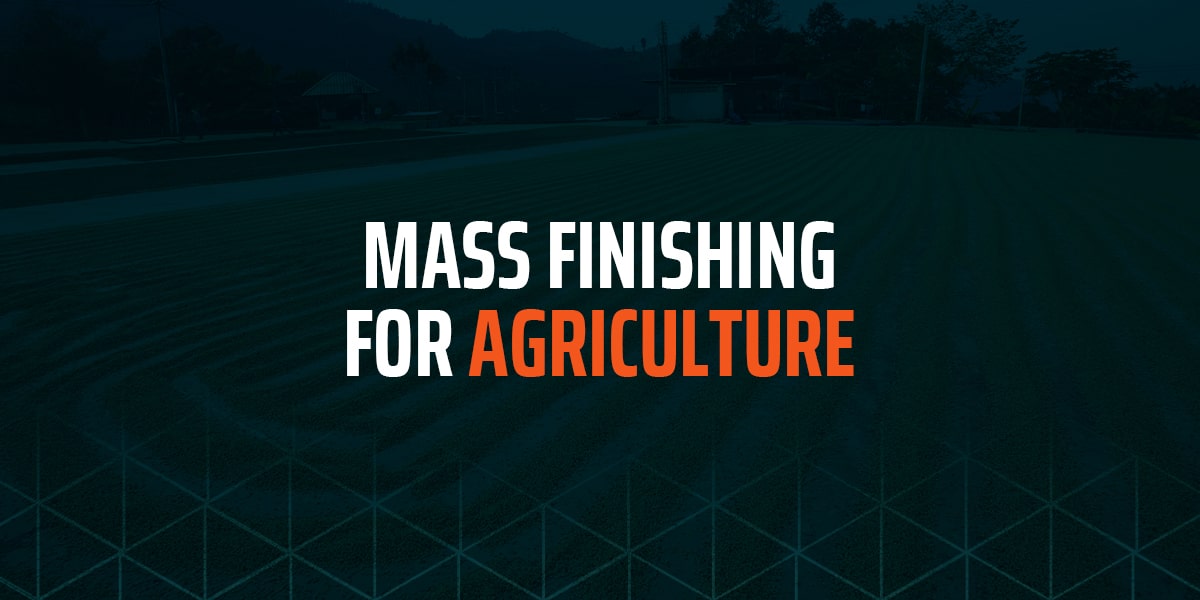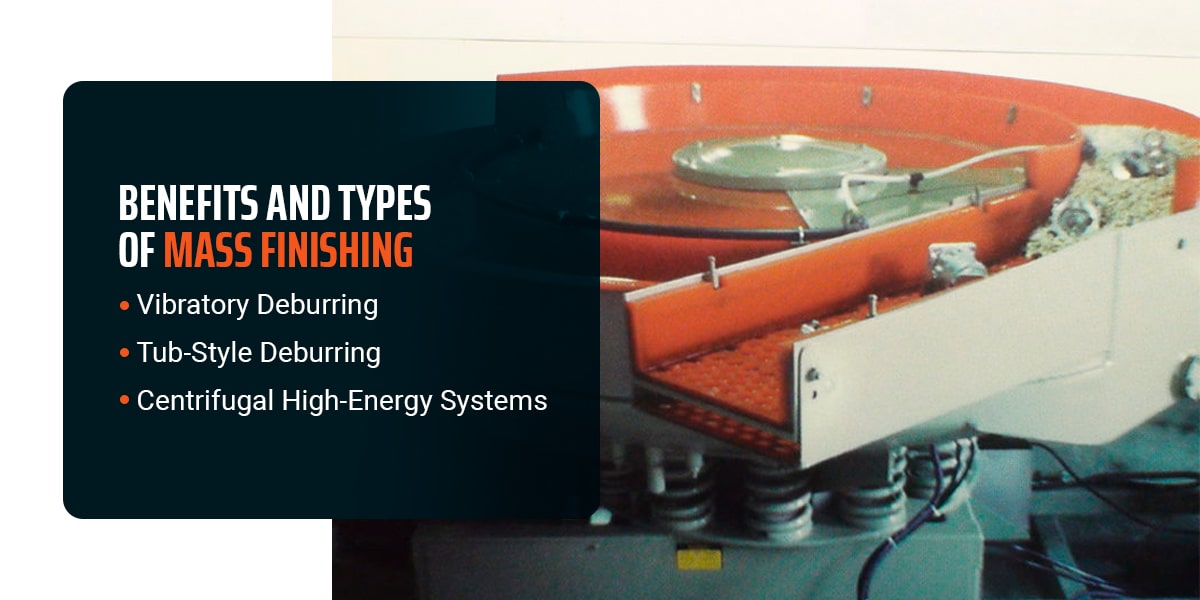
Mass Finishing for Agriculture
Mass finishing is a valuable process in numerous industries. This process allows products to be manufactured at scale and undergo further finishing in large batches. Mass finishing ensures parts are entirely clean, smooth and free of burs, readying them for any further steps necessary for packaging and distribution.
The agricultural industry encompasses different types of farming, including crop, commercial, stock and subsistence farming, and it requires a great deal of specialized equipment. Mass finishing for agricultural products keeps these vital resources accessible and cost-effective.
How Mass Finishing Is Used for Agriculture
In agriculture, there are numerous tools and components that may undergo mass finishing to ensure they are ready for use. A few of these include:
- Metal parts for vehicles and tractors used for farming: These may include components like combine or harvester parts, housings, panels, hood supports, vents, exhausts, handrails and engine parts like the transmission, axle, differential and driveshaft.
- Hand-held farming equipment for plowing and digging: Hand tools like shovels, rakes, sickles and scythes benefit from finishing processes after production.
- Irrigation system parts and components: Watering solutions like pipes, ball and butterfly valves, sprinklers and pumps need must be finished properly to ensure leak-free performance.
Though the exact process will vary based on the type of part, the steps involved in mass finishing generally include the following:
- Cleaning: This process clears the workpiece of dust and other particles to prevent contamination of the finishing media.
- Deburring: Here, components are tumbled with abrasive media to remove sharp ridges and edges. Media types include nutshells, steel, rock and plastic.
- Inhibiting: An inhibitor is applied to prevent rust and oxidation. This measure is vital for machinery and equipment that is exposed to the elements regularly, such as irrigation and harvesting tools.
- Polishing: This step ensures parts are clean and free of rough edges while providing high shine and quality. Depending on the target level of polish, other agents may be necessary to achieve the desired result.
- Drying: Some metal parts can corrode quickly if they are exposed to moisture. Drying components after a finishing process will stave off rust formation.

Benefits and Types of Mass Finishing
Agriculture involves many types of production methods and often uses mechanical solutions over manual labor to cope with the sheer volume of product generated. As such, mass finishing for agriculture has distinct benefits that improve operations and overall efficiency. Some of these include:
- Lower turnaround times.
- Optimal efficiency in cleaning, smoothing, deburring and polishing processes.
- Precise parts that yield improved performance.
- Better uniformity of parts.
- Lower overall costs thanks to efficiency increases.
Mass finishing equipment also supports safety in food processing applications by enabling easier cleaning for equipment used to harvest foods like grains, rice, beans, sunflower seeds and nuts. Abrasive tumbling or blasting removes jagged edges and polishes surfaces to ensure no metal fragments or other material from the equipment contaminates the harvest.
Different systems are used to attain these benefits. Here’s how they work to ensure products perform exactly as intended.
Vibratory Deburring
This method of deburring uses rough, abrasive media like steel and ceramic fragments to smooth components with consistent vibrations at high speeds. Round bowl vibrator machines are commonly used for smaller objects while thru-feed style vibratory machines assist in deburring larger items in a conveyor-like style. The bowl or tub’s vibrations continually move the parts and media against each other so the abrasives can act on the components’ surface and leave behind a smooth finish.
Tub-Style Deburring
Using kinetic energy, tub-style deburring rolls parts over in a continuous motion in a large tub. This style of deburring tends to be more forceful, although softer media can be used to enhance the polishing process. If the next steps of production require painting, a tub-style deburring machine is often sufficient to handle the surface preparation process. When made sufficiently large, this machine is ideal for bigger components like vehicle and tractor parts used in farming.
Centrifugal High-Energy Systems
Instead of kinetic energy, this system produces g-forces rising above 30Gs within four rotating barrels spinning at over 300 rpm. Here, direct contact friction is eliminated when the force pushes the components to the edges of the barrels. They do not tumble or vibrate, but the media is able to contact and polish them by virtue of the rotational force.
Call 800-553-7060 For Expert Advice
Examples of Mass Finishing in Agriculture
A few examples of agriculture equipment that benefit from mass finishing processes include the following:
- Plow blades: Smooth, deburred blades allow for precision cutting and loosening soil during harvesting.
- Smooth-ridged roller segments: These agricultural tools are pulled over the earth by a tractor as part of the soil-flattening process.
- Seed-counting machine parts: Mass finishing is perfect for the precision components required for this piece of equipment to run accurately.
- Drip irrigation systems: Valves, pipes and tubing used for these irrigation systems can be mass finished for exact water distribution through the sprinklers.
- Irrigation sprinkler systems: The sprinkler head is vital for spreading water evenly across the soil. Mass finishing will leave it in optimal condition to perform as intended.
- Rice huller: This machine helps remove the chaff or husk casings from grains and rice.
- Sickle and scythe blades: Having the ideal finish on your blades will help ensure a swift harvest, saving you time, effort and money.
- Pitchfork tines: As with blades, having sharp hayfork tines will make it possible to do the job with less effort.
- Grinder-mixer machine parts: Mass finishing the smaller parts of this machine for smooth operation will support its ability to grind and pulverize constituents like grain and rice.
The Importance of Mass Finishing for Agricultural Equipment
Mass finishing supports many areas related to agricultural and farming applications. Ag equipment manufacturers use this process to produce and finish large volumes of parts at once to control costs and maintain quality. On the end user’s side, finishing solutions can be used to clean parts at different phases of the harvest process and help keep cutting tools in optimal condition.
Modern mass finishing technology is integral to farmers and ranchers being able to maintain strict hygiene standards, keep their machinery at its most efficient and generate premium product.
Advanced Deburring & Finishing Is the Solution to Your Agricultural Deburring Needs
Advanced Deburring & Finishing is an industry leader in the mass finishing sector. We’ve helped businesses reduce lead times and improve product quality since 1986, offering parts cleaning, surface finishing and other solutions for operations around the world. Our team will work with you to provide an agriculture-focused mass finishing system that fits your requirements and equips you to do your best work.
If you’re looking for the latest metal finishing technology, we can help. Call us at 800-553-7060 or submit a request form and we will call you back to discuss your requirements.
Read More

